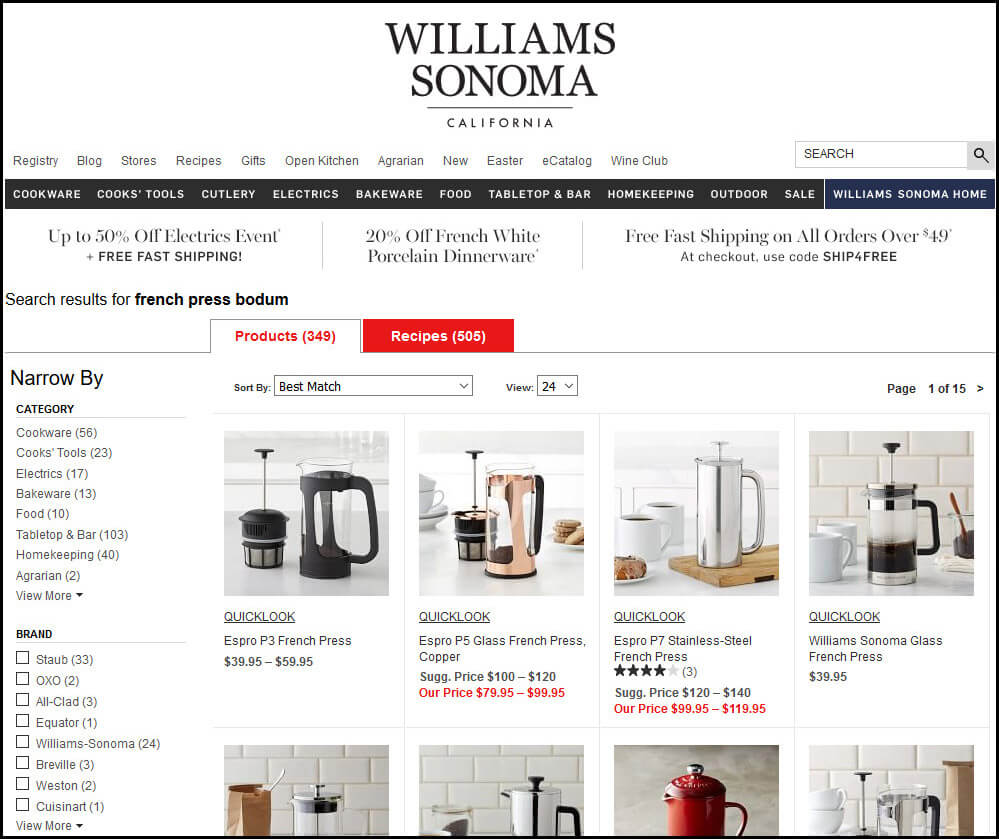
Two years ago, Multi Time Machine brought a lawsuit against Amazon for trademark infringement, alleging that web pages on Amazon.com for “MTM special ops watches” keyword searches could be too confusing to consumers, since the MTM watches are not sold on the site. Now, a similar complaint was brought by Bodum versus Williams-Sonoma for French press coffeemakers. These cases illustrate significant risks for e-commerce sites.
Multi Time Machine’s complaint was based on a few different search results pages at Amazon that involved keywords associated with Multi Time Machine’s trademarks. When one searched for “mtm special ops watches” (and similar keyword searches that could be related to their marks), Amazon displayed what are essentially related search results. As mentioned before, MTM watches are not sold on Amazon — but the site associated those keyword searches with other watches that might be considered similar.

Initial Interest Confusion
Multi Time Machine claimed that this caused “Initial Interest Confusion” (IIC), which is a controversial theory of trademark law. IIC is a legal premise with a hazy definition that allows a court to find infringement has occurred when there is an initial confusion on the part of a consumer about the provenance of a product before it is ultimately bought — even if that confusion no longer exists at the point of sale. Wikipedia provides the following hypothetical example:
West Coast Video’s competitor, Blockbuster Video, puts a billboard on a stretch of highway advertising a West Coast Video at an upcoming exit. In reality, there is no West Coast Video at this exit; it is a Blockbuster Video instead. The consumer, expecting to find a West Coast Video store, sees the Blockbuster Video and decides to patronize the suitable replacement. Even though the confusion has been dispelled, Blockbuster is still misappropriating the acquired goodwill of West Coast Video’s trademark.
So, you can see that IIC is intended to address a potentially unfair attempt to profit from a competitor’s mark.
Critics of IIC believe that it may be too hazy a concept, and that the definition is too imprecise. From my layman’s understanding, the idea of a bait-and-switch scenario would seem to have some element of uncontroversial and unfair fraud attached to it, and perhaps the degree to which consumers will comprehend the mistake in brand identification by the time of making the purchase could be the deciding factor as to whether it’s legally actionable or not.
Attorneys have expressed that there may be insufficient case law precedent to make it clear how solid the IIC concept really is. There is uncertainty about how it may be interpreted, and that leaves open the door to lawsuits based upon an uncomfortably loose concept. Some of the more persuasive critics argue that the concept should be abandoned in favor of the more specific tests established for whether or not infringement has occurred, period.
A district judge initially dismissed the MTM/Amazon suit in a summary judgment, finding that Multi Time Machine failed to show that the search results actually confused consumers. Upon appeal, the Ninth Circuit court ruled that the search results could be confusing to consumers, and the suit could go forward. Then, a few months later, the appellate court reversed its decision, finding that since Amazon had clear labeling of the search results, “… no reasonably prudent consumer accustomed to shopping online would likely be confused as to the source of the products.”
Confused about Initial Interest Confusion yet?
The back-and-forth reversals garnered a lot of attention in legal circles. In the ultimate ruling, the court noted that the alleged confusion was caused not by the design of a competitor’s mark, but by the design of a web page that displayed MTM’s mark and offered the competing product for sale. The case could be decided simply by evaluating whether the web page was likely to cause a “reasonably prudent consumer” to be confused about the origin of the goods.
The court focused upon the labeling and appearance of the product listings and the surrounding context on the screen displaying the results page, and they cited that they made their determination based on two questions:
- Who is the relevant, reasonable consumer?
- What would he or she reasonably believe based on what he or she saw on the screen?
Bodum vs. Williams-Sonoma
Fast-forward to last year through this spring, and a similar case was brought against Williams-Sonoma by Bodum, a seller of French press coffeemakers.
The Bodum vs. Williams-Sonoma case varies somewhat from the MTM/Amazon one. Bodum French press coffeemakers were carried by Williams-Sonoma in the past, but the company eventually dropped Bodum as a vendor. Subsequently, Williams-Sonoma began selling their own French press coffeemakers.
For anyone who has worked in corporate America, one can imagine the sequence: after selling a brand-name product for a period of time, a retailer begins to consider that they could source the manufacture of the product themselves, cutting out their vendor in order to increase the profits. This dynamic happens all the time and, in of itself, would not necessarily be legally actionable.
However, Bodum claimed that Williams-Sonoma went on to purposefully create an infringing situation by continuing to use the Bodum name on their website, while displaying non-Bodum products. I was able to obtain a screen-grab of a “Bodum” results page from the Williams-Sonoma.com website prior to them suspending the page:
The case was settled in April, but I think the situation involved still raises a lot of questions.
Assuming the claims had been found to have merit, this case could have been an example to demonstrate Initial Interest Confusion. The difference between the MTM/Amazon case and the Bodum/Williams-Sonoma case is perhaps that one would imagine that frequent customers of Williams-Sonoma, already familiar with the Bodum products, could easily have been very confused about the origination of the more
recent Williams-Sonoma French press products that replaced the Bodum ones that were previously carried.
Further, when those consumers searched in Google or searched on the Williams-Sonoma website for “Bodum,” they were arguably wanting the specific brand’s products that they were familiar with, and if the online website serves up products that are quite similar to the Bodum ones they were previously selling, the customers could arguably be thinking that they are indeed purchasing actual Bodum brand products at the point of sale.
I would conjecture that an additional argument could have been that the Bodum and Williams-Sonoma brands might have been so closely associated with one another in the minds of Williams-Sonoma customers, and the products displayed were similar enough, that a consumer might have reasonably thought that he or she was being presented with Bodum products when shown the search results page that was in contention.
I did just one comparison, using a Bodum French press coffeemaker page from the Williams-Sonoma website I found in the Internet Archive’s Wayback Machine from when they still carried Bodum products (left), and you can see the non-Bodum French press currently found on their website (right) for comparison. The products and their styling in the catalog photos are strikingly similar:

Making a case: Factors for consideration
In the MTM/Amazon case, the court essentially found that there was not Initial Interest Confusion because of a few factors:
- The Amazon search results page states that it is showing “related” results.
- The pages of the products listed on that page do not represent that they were Multi Time Machine watches.
- Consumers should reasonably recognize that the products presented were too inexpensive to be Multi Time Machine watches.
From my layman’s perspective, Williams-Sonoma may not have the same mitigating factors that Amazon had. The williams-sonoma.com site customers had come to expect to see Bodum products on the site. Likewise, consumers searching in Google for “bodum french press” were presented with a Google search results page where the Williams-Sonoma “related search results” page for “bodum” was listed prominently in the number-one position. The products presented closely resemble the Bodum brand products, so those familiar with Bodum items would not be likely to recognize that they are different from the bona fide branded ones. The prices are quite similar.

How the Bodum French Press page on the Williams-Sonoma.com website appeared on Google search results
[Read the full article on Search Engine Land.]
Some opinions expressed in this article may be those of a guest author and not necessarily Marketing Land. Staff authors are listed here.
About The Author

Popular Stories
Related Topics

